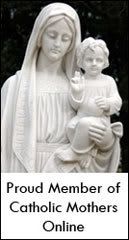 El Greco -- 1606
El Greco -- 1606On Friday, Nov 30, the Catholic Church celebrated the feast of the first-called Apostle. This is the one who got Peter to follow Jesus -- and didn't fuss when Jesus chose his brother Peter over himself. St. Andrew truly is a marvel -- tradition says that he was killed by crucifixion and that while he was dying (which took two days!), he preached the good news the whole time!
Well, the protoclete's feast is often at the beginning of Advent and we often overlook celebrating. This year, Advent doesn't start until Dec 2nd, so we were able to really celebrate St. Andrew's feast day ... lots of fun activities for the littles and great food too.
Here's what we made for dinner:
SALMON PATTIES (serves 6) http://southernfood.about.com/od/salmonrecipes/r/bln544.htm
INGREDIENTS:
· 1 can (16 ounces) salmon
· 1 clove garlic, minced
· 2 tablespoons minced fresh parsley
· ground black pepper, to taste
· 2 large eggs, well beaten
· 1 to 1 1/2 cups fine dry bread crumbs
· 3 tablespoons butter
PREPARATION:
Turn salmon and liquid into a medium mixing bowl. Flake with a fork, removing OR mashing any bones (they are edible). Mix in grated onion, parsley and pepper. Mix beaten eggs with salmon. Add enough bread crumbs, about 1/2 to 3/4 cup, to make thick enough to shape into 12 small patties.
Roll patties in 1/2 cup bread crumbs. In a large heavy skillet over low heat, melt 2 tablespoons of butter; add patties. Fry patties slowly on one side; add remaining butter, turn patties and fry until brown on the other side. Serves 6.
Cheddar and Black Pepper Scones http://www.kingarthurflour.com/shop/recipe.jsp?recipe_id=R766
Scones, formerly known mainly to fanciers of British food, have become very familiar to most of us on this side of the ocean, due to their bakery and coffee-shop popularity over the past 5 years or so. Wedges, squares or circles of a buttery biscuit-type dough, baked quickly at high heat till golden brown, scones usually come plain or dotted with fruit or nuts. Spread with butter and jam or preserves, they've become a staple at breakfast and tea time.But scones needn't be thought of as simply a sweet treat. Offer a savory version in the bread basket at your main meal. They're very similar to baking powder biscuits, and are easily seasoned to go with whatever you're serving.
Ingredients:
- 3 cups King Arthur Unbleached All-Purpose Flour
- 2 tablespoons baking powder
- 1/2 teaspoon baking soda
- 1 teaspoon salt
- 1 tablespoon granulated sugar
- 1/2 cup (1 stick) unsalted butter
- 1 cup (4 ounces) grated Cheddar cheese
- 1 tablespoon coarsely ground black pepper*
- 3/4 cup (6 ounces) buttermilk or plain yogurtmilk (for glaze)
*This amount of black pepper will make very spicy scones. For less heat, decrease the amount of pepper.
In a large bowl, sift together the flour, baking powder, baking soda, salt and sugar. Cut in the butter and cheese. Stir in the black pepper. Refrigerate the dough for half an hour.
Gently stir in the buttermilk or yogurt. Gather the mixture into a ball with your hands, and on a well-floured surface roll or pat the dough into a 12 x 8-inch rectangle or circle approximately 3/4-inch thick.
Yield: about 40 small scones or 12 nice size pie-slices.
And for dessert:
Tandra Cakes (http://www.catholicculture.org/liturgicalyear/recipes/view.cfm?id=1517 )
In parts of England Saint Andrew is considered the patron of lacemakers — perhaps coming from the resemblance of intersecting threads in certain types of lace to the cross of Saint Andrew. Seventeenth-century bakers made cakes or buns known as Tandry or Tandra "Wigs," composed of plain dough in wedge shape, ornamented with currants and caraway seeds. This makes a REALLY tasty dessert bread that's not overly sweet (and it makes fantastic toast the next day!).
Ingredients:
- 3 cups all-purpose flour
- 1 teaspoon salt
- 2-1/4 tsp yeast (one packet)
- 1 teaspoon sugar
- 1 cup water
- 1 egg
- 1/2 cup butter
- 1/2 cup currants
- 1/2 cup sugar
- 1/2 – 1 cup chopped candied lemon peel (crystallized)
DIRECTIONS
Mix the flour and salt, then sift into a mixing bowl. Slightly warm the water in a different bowl and add to it a mixture of yeast and sugar. Blend and put aside until the frothing stops. Mix in a beaten egg and slowly add the mixture to the flour and salt. Next slowly melt the butter and, when cool, add the mixture, stirring until smooth. Knead, cover and leave to rise.
After doubling in size, knead in the currants, sugar and lemon peel, then transfer it to a 2 lb loaf pan. Leave until the dough has risen to the top, then bake in a moderate oven (350ºF) until golden-brown, approximately 1 hour.




 ...
... 



No comments:
Post a Comment